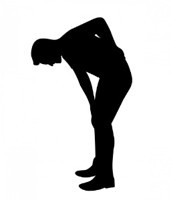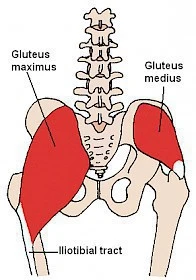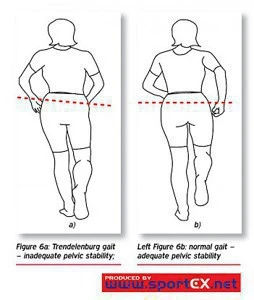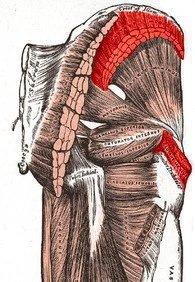Targeting the Gluteal Muscles for Low Back Pain

by Abby Stewart, LMT
Most likely, either you or someone you know has dealt with periods of low back pain that limits their activity level and emotional well-being. Low back pain is one of the most prevalent musculoskeletal conditions in contemporary society worldwide; it is estimated that upwards of 80% of adults experience low back pain at some point in their lives. In addition to causing pain and frustration, low back pain is a costly problem. Many missed work days, job-related disabilities, and healthcare insurance claims are the result of this pervasive disorder. Symptoms can vary from sharp pain set off off by certain movements to a dull pain that persists almost constantly. Pain can be chronic or acute, and can be a minor annoyance or nearly debilitating to the individual. Low back pain can be attributed to many different causes, most of which are mechanical in nature, such as: disc degeneration, spondylolisthesis, spinal stenosis, herniated/ruptured discs, radiculopathy, arthritis, sprains or strains, etc. Although rare, conditions such as infections, tumors, kidney stones, and other serious issues can be the cause; in which case consulting with a medical doctor is necessary.
For mechanical causes of low back pain, massage therapy is often an under-utilized treatment. Those afflicted most often seek out a medical doctor, who can either prescribe medication to manage the pain, refer for imaging (which is very helpful in cases of injury, trauma, or cases that worsen), or recommend injections such as epidurals. Doctors will often prescribe physical therapy, which can be costly (depending on the patient’s insurance plan) and time-consuming. Many times, patients will try these conventional treatments before turning to more alternative treatments like massage therapy or acupuncture.
When someone with a history of mechanical low back pain comes in for a massage, they typically think of their spine as being a fragile structure. Often, they instruct the massage therapist to not do any “deep” work in the low back area, or even not to touch it at all to prevent the condition from worsening. While thi s is a feasible request, it isn’t based on any evidence. The human spine is an incredibly strong and flexible structure; bipedalists rely on the spine’s strength to support much of the body weight and allow for freedom of movement in every plane. However, in order for the massage client to relax and benefit from the therapy, they must be relaxed and trust the therapist. In this case, the massage therapist can target the glute muscles.
s is a feasible request, it isn’t based on any evidence. The human spine is an incredibly strong and flexible structure; bipedalists rely on the spine’s strength to support much of the body weight and allow for freedom of movement in every plane. However, in order for the massage client to relax and benefit from the therapy, they must be relaxed and trust the therapist. In this case, the massage therapist can target the glute muscles.
Many people with low back pain also experience pain in the gluteal region. The iliac crest divides the low back and gluteal region, and no muscles cross this bony ridge. Trigger points in the gluteal muscles can oftentimes refer pain up into the lower back, and patients typically tolerate deeper work in this area. The glutes are not seen as “fragile” and there is typically an abundance of muscle mass to work with, thus making it easier for the client to relax. The upper ridge of the gluteus maximus is an excellent place to start. Applying pressure from the medial-most corner of the iliac crest, you will find a tender spot that commonly refers pain up into the low back. It is just inferior to the PSIS (posterior superior iliac spine); this area appears on some people as “low back dimples.” With pressure on this area, the patient should experience a dull, aching sensation in both upwards and downwards directions; if it is sharp or painful, the therapist may be pressing too close to the sacrum.
Moving laterally to the deeper glu teus medius and minimus muscles, there may be other tender points along the superior attachment of the gluteus maximus which can also contribute to low back pain. Trigger points within the gluteus medius and minimus can refer pain up into the low back, hip, or down the leg, often mistaken for sciatica. These muscles perform hip abduction and stabilize the hip joint during the gait cycle. If they are weak, gait is compromised and the whole body becomes affected; this is referred to as a Trendelenbug gait. (The “clamshell” exercise is an excellent and simple way to strengthen these muscles). To access these muscles, palpate the greater trochanter and move superiorly toward the iliac crest. Many people have trigger points about halfway between these bony structures, in the thickest part of their muscle bellies.
teus medius and minimus muscles, there may be other tender points along the superior attachment of the gluteus maximus which can also contribute to low back pain. Trigger points within the gluteus medius and minimus can refer pain up into the low back, hip, or down the leg, often mistaken for sciatica. These muscles perform hip abduction and stabilize the hip joint during the gait cycle. If they are weak, gait is compromised and the whole body becomes affected; this is referred to as a Trendelenbug gait. (The “clamshell” exercise is an excellent and simple way to strengthen these muscles). To access these muscles, palpate the greater trochanter and move superiorly toward the iliac crest. Many people have trigger points about halfway between these bony structures, in the thickest part of their muscle bellies.
The therapist can also explore the inferior half of the gluteal region, starting with a broader contact such as a forearm or fist and advancing to a smaller point of contact only if the client is relaxed and tolerates it. Both client and therapist may be more comfortable during the massage if the gluteal region is covered with a sheet; the bony landmarks of this area (sacrum, iliac crest, and greater trochanter) are easily palpated through a sheet or clothing. This becomes especially important when working in the medial half of the glute, close to the edge of the sacrum.
landmarks of this area (sacrum, iliac crest, and greater trochanter) are easily palpated through a sheet or clothing. This becomes especially important when working in the medial half of the glute, close to the edge of the sacrum.
Additional techniques to employ for low back pain include lower extremity traction and low back rocking. Applying a distraction force to the leg creates space in the hip and low back joints. Lastly, one way to work directly on the low back in a gentle and safe manner is to use a rocking technique. This helps to relax muscles, calm the nervous system, and create movement in the joints. It can be done at any point during the massage session, either on its own or incorporated into other techniques.
Additionally, positioning is another concern for those suffering from low back pain. While in a prone position, it may be helpful to remove the bolster under the client’s ankles and/or place a thin pillow, bolster, or blanket under their hips to decrease extension in the lumbar spine. When in supine, a bolster under the knees may be helpful as well.
Some people with low back pain may tell their massage therapists not to work directly on the low back. In this case, deeper work in the gluteal region, lower extremity traction, and rocking techniques can be beneficial at easing back pain. Respecting boundaries and cultivating trust between the client and massage therapist are crucial to facilitate healing.
tag @yinyanghouse for questions/comments
- Great Tonify the Yin Pill (Da Bu Yin Wan)
- Solitary Hermit Teapills (Du Huo Ji Sheng Wan)
- Six Ingredient Pill with Rehmannia (Liu Wei Di Huang Wan)
- Remove Stagnant Blood from a Painful Body Pills (Shen Tong Zhu Yu Wan)
- Eight Flavor Rehmannia Teapills (Zhi Bai Di Huang Wan)
- Sciatica Pills (Zuo Gu Shen Jing Tong Wan)